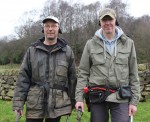 It’s the first gold hoard of the year! We’ve had Bronze Age weapons and Roman copper vessels packed with plants. Now we have a group of four ancient gold torcs discovered by metal detectorists in a cow pasture in Leekfrith on the Staffordshire Moorlands.
It’s the first gold hoard of the year! We’ve had Bronze Age weapons and Roman copper vessels packed with plants. Now we have a group of four ancient gold torcs discovered by metal detectorists in a cow pasture in Leekfrith on the Staffordshire Moorlands.
The torcs were found last December by Mark Hambleton and Joe Kania. Hambleton had scanned the field some two decades ago without success. 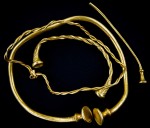 They were about to give up when Joe Kania’s machine signalled the presence of metal. All they’d found up to that point was trash and a 19th century coin or two, so Hambleton had already packed up his metal detector when Kania pulled a gold torc out of the ground. Then another. And another. And another. Three of them are necklaces, one a bracelet. Three are complete and intact, the fourth broken, likely by agricultural interference. The torcs were about six inches beneath the surface about a meter (three feet) apart from each other.
They were about to give up when Joe Kania’s machine signalled the presence of metal. All they’d found up to that point was trash and a 19th century coin or two, so Hambleton had already packed up his metal detector when Kania pulled a gold torc out of the ground. Then another. And another. And another. Three of them are necklaces, one a bracelet. Three are complete and intact, the fourth broken, likely by agricultural interference. The torcs were about six inches beneath the surface about a meter (three feet) apart from each other.
 Hambleton spent a fitful night failing to sleep with the hoard by his side. The next morning, the finders alerted the Portable Antiquities Scheme to their discovery. Stoke-On-Trent City Council dispatched archaeologists to the field but they found no evidence of further treasure. Hambleton and Kania defied the odds again, though, returning to the spot last Sunday where they discovered the second half of the broken torc.
Hambleton spent a fitful night failing to sleep with the hoard by his side. The next morning, the finders alerted the Portable Antiquities Scheme to their discovery. Stoke-On-Trent City Council dispatched archaeologists to the field but they found no evidence of further treasure. Hambleton and Kania defied the odds again, though, returning to the spot last Sunday where they discovered the second half of the broken torc.
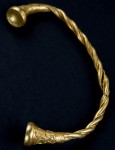 The Leekfrith Iron Age Torcs were examined by Dr. Julia Farley, the British Museum’s Curator of British & European Iron Age Collections. She determined they were not of British origin, but likely from what is today Germany or France. Analysis of the gold content found that it was no less than 80% in every torc, making them more than 18 carat gold which is 75% pure. The torcs weigh between 31 grams for the smallest piece, the incomplete bracelet, and 230 grams for the largest. The one bracelet stirred particular excitement because it is decorated, etched with lines inside loops. This is some of the earliest Celtic art ever discovered in Britain. All of the workmanship on the torcs is extremely high quality. One of them even has an incredibly rare maker’s mark.
The Leekfrith Iron Age Torcs were examined by Dr. Julia Farley, the British Museum’s Curator of British & European Iron Age Collections. She determined they were not of British origin, but likely from what is today Germany or France. Analysis of the gold content found that it was no less than 80% in every torc, making them more than 18 carat gold which is 75% pure. The torcs weigh between 31 grams for the smallest piece, the incomplete bracelet, and 230 grams for the largest. The one bracelet stirred particular excitement because it is decorated, etched with lines inside loops. This is some of the earliest Celtic art ever discovered in Britain. All of the workmanship on the torcs is extremely high quality. One of them even has an incredibly rare maker’s mark.
Dr. Farley:
“This unique find is of international importance. It dates to around 400–250 BC, and is probably the earliest Iron Age gold work ever discovered in Britain.
“The torcs were probably worn by wealthy and powerful women, perhaps people from the continent who had married into the local community. Piecing together how these objects came to be carefully buried in a Staffordshire field will give us an invaluable insight into life in Iron Age Britain.”
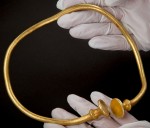 A coroner’s inquest was held in North Staffordshire on Tuesday. Coroner Ian Smith asked questions of experts about the hoard, its continental origin and how they pieces may have made their way to Leekfrith. After hearing testimony about the torcs’ age and precious metal content, the coroner ruled that the pieces are treasure trove. The next step is for the independent experts of the Treasure Valuation Committee to determine fair value of the torcs. Local museums will then be offered the first opportunity to raise the amount of the valuation. That money will be divided between the finders and the landowner.
A coroner’s inquest was held in North Staffordshire on Tuesday. Coroner Ian Smith asked questions of experts about the hoard, its continental origin and how they pieces may have made their way to Leekfrith. After hearing testimony about the torcs’ age and precious metal content, the coroner ruled that the pieces are treasure trove. The next step is for the independent experts of the Treasure Valuation Committee to determine fair value of the torcs. Local museums will then be offered the first opportunity to raise the amount of the valuation. That money will be divided between the finders and the landowner.
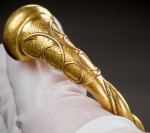 Stoke-on-Trent, which is bidding to be a 2021 UK City of Culture, is mighty keen to secure the torc hoard. Another little hoard you might have heard of, the Staffordshire Hoard, spends half its time in Stoke and it has brought millions of tourists and their cash to the region. The Leekfrith Iron Age Torcs will be on display in the Potteries Museum and Art Gallery in Stoke-On-Trent, one of two local museums that share custody of the exceptional Staffordshire Hoard, for three weeks before they go back to the British Museum for valuation.
Stoke-on-Trent, which is bidding to be a 2021 UK City of Culture, is mighty keen to secure the torc hoard. Another little hoard you might have heard of, the Staffordshire Hoard, spends half its time in Stoke and it has brought millions of tourists and their cash to the region. The Leekfrith Iron Age Torcs will be on display in the Potteries Museum and Art Gallery in Stoke-On-Trent, one of two local museums that share custody of the exceptional Staffordshire Hoard, for three weeks before they go back to the British Museum for valuation.
See Joe Kania and Mark Hambleton tell the story of the discovery (notice the awesome traditional dry stone walls behind them as they goof around for the camera in beginning; I love a quality dry stone wall) and Staffordshire officials glow with happiness over their shiny new babies in this video:
[youtube=https://youtu.be/87o-w0xCj7s&w=430]